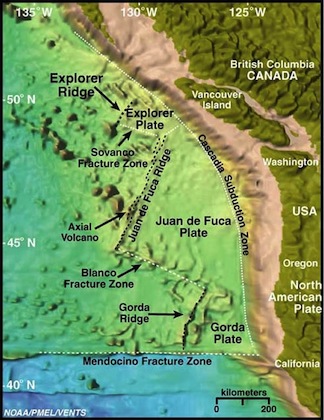360315-dangerousfuture.jpg

The Cascadia Subduction Zone is a 1,000-kilometer-long subduction zone stretching from California to British Columbia. Credit: National Oceanic and Atmospheric Administration
When most people talk about the “next big earthquake,” they usually mean a major temblor along the San Andreas Fault in southern California. But research over the last few decades suggests that the next big one might strike a little farther north — from northern California to southern British Columbia.
The source of this future quake is the Cascadia subduction zone, off the coast of the Pacific Northwest. The crustal plate that contains the North American continent is sliding over smaller plates that make up part of the ocean floor — or at least it’s trying to. At a depth of about 20 miles, the plates are sticking together, creating a tremendous stress. When the stress becomes too great, that sticking point will snap, creating a massive earthquake.
Geologists have found that the Cascadia produces quakes of magnitude nine or greater every 500 years or so. The last one took place in 1700. It also generated a tsunami that caused damage as far away as Japan.
A study a few years ago found a roughly 10 to 15 percent chance of such a massive quake in the next 50 years. If one hit the region today, the quake itself would probably last for several minutes. Massive aftershocks would begin within hours and continue for months. And a tsunami would race outward from the trigger point, slamming the coasts of Oregon and Washington with waves that could reach elevations of up to a hundred feet when they hit shore — devastation from a clash far beneath the ocean floor.

